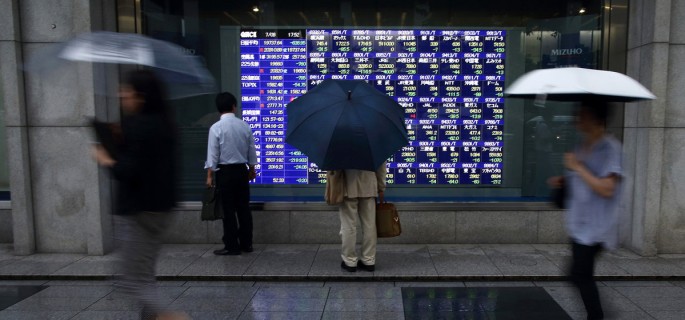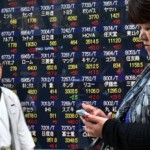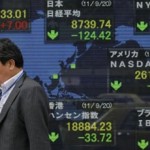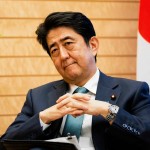Yen Plunges and Japan Stocks Rebound on Stimulus Bets; Oil Sinks

-
Aussie jumps after inflation data, before reversing gains
-
U.S. stock-index futures climb on Apple’s after-market rally
The yen dropped as Japan’s Prime Minister was reported to commit to a $265 billion stimulus package. Chinese stocks tumbled and crude oil extended its slump, while European shares advanced for a third day.
Japan’s currency weakened 0.9 percent against the dollar after Kyodo News said that Shinzo Abe announced plans for more than 28 trillion yen ($265 billion) in spending to boost the economy. The Nikkei 225 Stock Average climbed 1.7 percent, while the yield on Japan’s two-year notes fell to a record. China’s Shanghai Composite Index slid 1.9 percent on a report that the banking regulator is considering curbs that would restrict wealth-management products from some investments in equities. Crude fell a fifth day, slipping below $43 a barrel. The Stoxx Europe 600 Index added 0.3 percent.

Japan’s financial markets have been whipsawed this week by speculation about the amount of money the government will commit to buoying the economy, and whether any stimulus will come as a coordinated effort with the Bank of Japan. Almost 80 percent of analysts surveyed by Bloomberg forecast Governor Haruhiko Kuroda and his board will expand their stimulus program Friday. The U.S. central bank is projected to keep borrowing costs on hold Wednesday, despite an uptick in bets on tightening this year.
“Fiscal policy is now really what the markets are looking for,” Lothar Mentel, chief investment officer at Tatton Investment Management, told Bloomberg TV in London. “It seems big and it should probably do quite a bit for the Japanese economy. Whether it’s big enough, we’ll find out. The markets seem to be a little bit undecided whether it is or it isn’t.”
Currencies
After a two-day, 1.4 percent advance, the yen weakened to 105.72 per dollar as of 8:01 a.m. in London.
Abe’s stimulus plan will include 13 trillion yen in “fiscal measures,” according to Jiji Press, which didn’t specify what that meant. There was no report on how much of the package would be new spending. Abe, speaking in the southern city of Fukuoka on Wednesday, said the package would be compiled next week, Kyodo said.
The Australian dollar jumped, then reversed gains, after data showed inflation quickened. The currency dropped 0.5 percent to 74.68 U.S. cents after rallying as much as 0.9 percent. Policy makers, who left the benchmark cash rate unchanged at a record low of 1.75 percent last month, make their next decision on borrowing costs on Aug. 2.
“The lift in the Australian dollar quickly faded because there is still a reasonable risk of a RBA rate cut next week,” said Joseph Capurso, a senior currency strategist in Sydney at Commonwealth Bank of Australia. Commentary after the Fed meeting “is more important for the short-term Aussie outlook. The Fed risks being more optimistic than their June statement, and that could help push the Australian dollar lower into the week’s end.”
New Zealand’s currency fell 0.5 percent. The Bloomberg Dollar Spot Index, a gauge of the greenback against 10 major peers, added 0.3 percent following Tuesday’s 0.3 percent drop.
Stocks
Automakers led gains on the European equity gauge after PSA Group, the region’s second-biggest carmaker, said first-half earnings jumped 32 percent. The MSCI All-Country World Index added 0.2 percent, trading near the highest level of the year.
The Topix index gained 1.1 percent, with suppliers of Apple Inc. climbing after better-than-expected sales from the iPhone maker. Minebea Co., which makes backlights for liquid crystal displays, soared 14 percent in Tokyo. Hon Hai Precision Industry Co., which assembles Apple devices, rose 1.4 percent in Taipei.
The Shanghai Composite tumbled as small-cap stocks sank, sending the ChiNext Index down more than 5 percent. Authorities may set a limit on how much wealth management products can invest in equities and “non-standard assets” such as loans, the 21st Century Business Herald reported, citing people it didn’t identify.
“There’s an obvious trend that the regulators want to strengthen market monitoring and lower the use of leverage in financial markets to control risks,” said Dai Ming, a fund manager at Hengsheng Asset Management Co.
Futures on the S&P 500 Index increased 0.2 percent, while contracts on the Nasdaq 100 climbed 0.6 percent as Apple shares jumped almost 7 percent in after-market New York trading. Apple’s boost contrasted with an 11 percent after-market slide in Twitter Inc., which forecast third-quarter revenue that fell short of analyst estimates.
Commodities
West Texas Intermediate crude slipped 0.4 percent, extending losses at its lowest price since April as industry data indicated supplies at the main Cushing oil hub in the U.S. rose to a seasonal record.
“The general driver behind the negativity seems to be the excess crude and gasoline stockpiles,” Angus Nicholson, a markets analyst at IG Ltd. in Melbourne, said by phone. “The market is very much in a down trend and it doesn’t look like it’s going to reverse at the moment. There is some key technical support around $40 a barrel.”
Source: Bloomberg





























